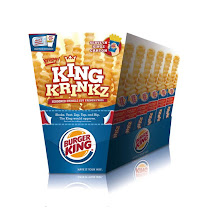 Supermarket News
Supermarket News has published a long, fascinating article about where the retail industry might go in the next decade.
Predicting the future isn't one of the smarter, safer things you can do. Events have a nasty way of turning out very differently than we planned. So let's look at some of the predictions and see where there might be some meat to all this:
1.) Digital Marketing: Just like its kin,
Social Networking, digital marketing is now the hot button topic. I suspect that's partly because we don't really understand it! But Social Networking has proved to be a bust in many cases (especially
Twitter). Downloading coupons to your loyalty card, sending coupons to cell phones, or even sending text messages about price reductions to shoppers passing a product they've purchased in the past all sound like science fiction, and you know how sexy Sci-Fi can be. It's easy to plan trips to other worlds because we don't have to pay for or actually take the trips. Since few of us understand the technology of digital marketing, we either embrace it blindly or shut up for fear of being classed as a troglodyte.
2.) More Information: There's some thought the push by consumers and the government for more nutritional and sustainability information will dovetail nicely with digital marketing, but again, this is more faith than either science or even "boots on the groud" marketing. Consumers appear to want more information, but delivering it remains the challenge, with information overload a likely outcome.
3.) Niche Stores & Small Footprint Retailers: Oh, yeah, for sure. The idea is that smaller is better for shoppers, that the age of the "crash buy" when mom took home a semi's worth of groceries is over. Then why have all the "small footprint" stores like
Tesco's Fresh & Easy,
Giant Eagle's Express,
Safeway's The Market and
Jewel's Urban Fresh all performed middling at best? The problem with the small retail footprint is it limits choices, and that clashes with the biggest development coming out of the retailing channel: Price and the Recession. Consumers want choice, not necessarily 1,000 SKUs of peanut butter, but choice on price, size and mostly, convenience. It's no wonder the most-successful retailer of the past decade has been
Walmart. Don't expect that to change anytime soon. It is true that America is running out of space for unlimited store and mall expansion, so optimizing the existing store locations will be a major focus of retail chains. But they will also face continuing competition from club stores, convenience stores, dollar stores and other non-tradtional retailers like Walgreens, who have shifted over to selling more foods, including an expanded line of fresh & frozen products.
4.) The World is Coming: Several of those interviewed in the article think more and more world retailers like France's Carrefour or Germany's Metro-AG will join Tesco here. Don't bet on it. Tesco has taken a bath on its Fresh & Easy stores, combining bad luck with poor management decisions. They opened the majority of their locations in California and Arizona, two of the states hit hardest by the Recession, and limited choices to a small number of SKUs, guessing Americans wanted to eat like Britons by taking home expensive prepared foods. Guess again! A trend that is more likely would be for the larger foreign chains who have a favorable exchange rate helping them to acquire some American firms (the Dutch company Royal Ahold, for example, owns Stop & Shop, Giant, Martin's and Peapod).
5.) Value: Everyone seems to think the Frugal Shopper is here to stay, even once the Recession is over later this year. So they're looking for cash & carry outfits like Aldi, Save-A-Lot and PriceRite to excell. But Americans are notoriously fickle about their buying habits, and I'm unconvinced that indulgence won't come back once times get better. We all know we should eat better, yet how many of us keep our New Year's resolutions?
6.) The Rise of the Ethnic: Here I think the article is dead-on. Americans are more and more interested in ethnic foods, and with the growing population of Hispanics and Asians especially, expect to see more grocers catering to these groups.
7.) Private Label: One of the experts profiled in the article predicts store brands will top 35% of dollar sales, soaring to perhaps 50% of unit sales (two times the current rates). He also says "retailers will become leaders in innovation rather than fast followers." Yeah? Well, one problem is that private label products continue to be co-packed (manufactured) by companies not owned or controlled by the stores. In many cases, the national brands are making the private label versions for stores to soak up excess production capacity. The notion that grocery retailers will lead in product innovation is, I think, mostly wishful thinking. The retailers know retailing, including managing inventory and cash receivables, not developing products.
The article is filled with other observations about the details of the grocery business and its micro-concerns, so I recommend it highly (though disagree with many of its conclusions).
This blog includes excerpts from a weekly round-up of food industry & food licensing news provided free to Broad Street Licensing Group's clients, and as a paid subscription service (6 months $695; 1 year $1,125).
Too busy to keep up with the news wires & publications about the food business? If you or your company would like to subscribe to our news service, call Danielle Foley at Broad Street Licensing Group (tel. 973-655-0598) and ask for your free sample or click on our website.

.gif)




























